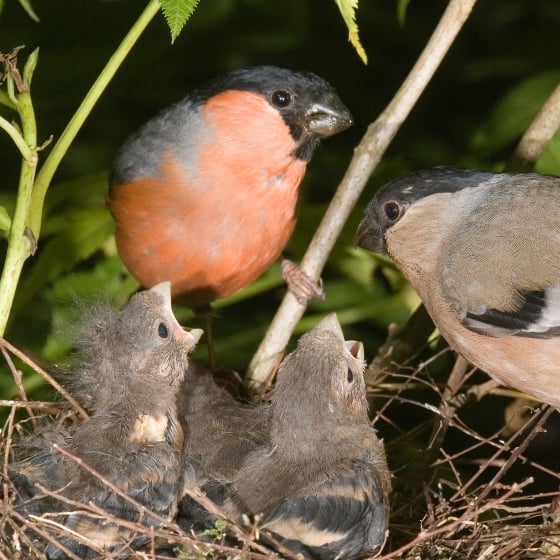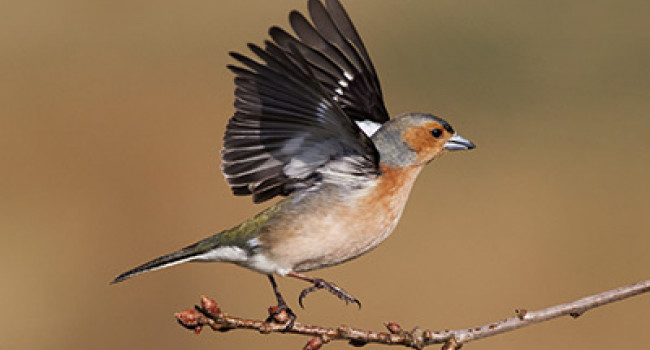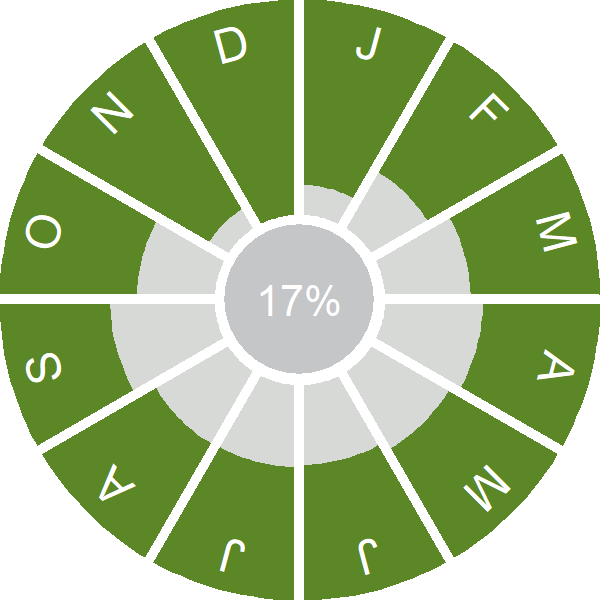Bullfinch
Pyrrhula pyrrhula (Linnaeus, 1758)
BF
 BULLF
BULLF  17100
17100

Family: Passeriformes > Fringillidae

A fairly sedentary resident species, the Bullfinch is distributed widely across Britain & Ireland. The highest densities of this lovely bird are found in lowland wooded landscapes.
The male has a striking bright pink breast and neck, contrasting with a smart black cap. The females are duller, but still highly attractive birds. Bullfinches can often be seen at garden bird feeders, and in spring they will visit garden fruit trees to nibble the buds. Their call is a soft single whistle.
There was a steep decline in UK Bullfinch numbers at the end of the 1970s and, though there has been an upturn in the fortunes of this species more recently, the population is still around 40% lower than in the 1960s. It may be that declining habitat quality and decreasing numbers of large orchards are impacting the population.
Exploring the trends for Bullfinch
Our Trends Explorer will also give you the latest insight into how the UK's Bullfinch population is changing.
trends explorerIdentification
Bullfinch identification is usually straightforward. The following article may help when identifying Bullfinch.
Identifying Chaffinch and Brambling

Chaffinch is one of our most common and familiar birds, but young birds and females are harder to identify than the stunning males. In winter, Chaffinches are joined by their northern cousins, Brambling. How can you pick them out in the midst of Chaffinches?
Help fund research into Chaffinch decline
The loss of Chaffinches in the UK requires urgent action now. We have developed a programme of research that will help to pinpoint the drivers of this decline. Find out how you can help.
... read moreSONGS AND CALLS
Listen to example recordings of the main vocalisations of Bullfinch, provided by xeno-canto contributors.
Begging call
Flight call
Alarm call
Call
Song
Develop your bird ID skills with our training courses
Our interactive online courses are a great way to develop your bird identification skills, whether you're new to the hobby or a competent birder looking to hone your abilities.
Browse training coursesStatus and Trends
Population size and trends and patterns of distribution based on BTO surveys and atlases with data collected by BTO volunteers.
CONSERVATION STATUS
This species can be found on the following statutory and conservation listings and schedules.
POPULATION CHANGE
The UK Bullfinch population entered a long period of decline in the mid 1970s, following a period of relative stability. The decline was initially very steep, and more so in farmland than in wooded habitats, but became shallower and eventually ended around 2000, since when there has been some increase. CES and CBC/BBS both suggest there are large annual fluctuations around the overall long-term trend. The BBS map of change in relative density between 1994-96 and 2007-09 indicates that major decreases in southern and western parts of the UK over that period contrasted with increases in northern England and eastern Scotland. There has been a decline across Europe since 1980 (PECBMS: PECBMS 2020a>). The UK conservation listing was downgraded from red to amber in 2009 (Eaton et al. 2009).
| UK breeding population |
-49% decrease (1967–2022) 
|
Exploring the trends for Bullfinch
Our Trends Explorer will also give you the latest insight into how the UK's Bullfinch population is changing.
trends explorerDISTRIBUTION
Bullfinches are relatively sedentary in Britain & Ireland, with a wide distribution. Densities are highest in lowland wooded landscapes, particularly in Ireland, and lowest in large conurbations and in upland areas. Bullfinches are absent from open country with few trees, such as around the Wash, in exposed coastal regions in western Ireland, and on many Scottish islands.
Occupied 10-km squares in UK
| No. occupied in breeding season | 2462 |
| % occupied in breeding season | 82 |
| No. occupied in winter | 2542 |
| % occupied in winter | 84 |
European Distribution Map
European Breeding Bird Atlas 2
Breeding Season Habitats
| Most frequent in |
Scrub 
|
| Also common in | Deciduous Wood |
Relative frequency by habitat
Relative occurrence in different habitat types during the breeding season.

DISTRIBUTION CHANGE
Overall breeding range size has changed little since the 1968–72 Breeding Atlas but this conceals a mix of gains and losses. There have been recent gains in western Ireland, on some Inner Hebridean islands and in northern and western Scotland; some of these may reflect an increase in tree planting in these exposed locations. Losses are associated mostly with upland edges or with coastal areas.
Change in occupied 10-km squares in the UK
| % change in range in breeding season (1968–72 to 2008–11) | -1% |
| % change in range in winter (1981–84 to 2007–11) | +10.2% |
SEASONALITY
Bullfinch is recorded throughout the year on up to 20% of complete lists.

Movement
Information about movement and migration based on online bird portals (e.g. BirdTrack), Ringing schemes and tracking studies.
RINGING RECOVERIES
View a summary of recoveries in the Online Ringing Report.
Foreign locations of birds ringed or recovered in Britain & Ireland

Biology
Lifecycle and body size information about Bullfinch, including statistics on nesting, eggs and lifespan based on BTO ringing and nest recording data.
PRODUCTIVITY & NESTING
Exploring the trends for Bullfinch
Our Trends Explorer will also give you the latest insight into how the UK's Bullfinch population is changing.
trends explorerSURVIVAL & LONGEVITY
View number ringed each year in the Online Ringing Report
Exploring the trends for Bullfinch
Our Trends Explorer will also give you the latest insight into how the UK's Bullfinch population is changing.
trends explorerBIOMETRICS
Wing Length 
|
Adults | 82.3±2.3 | Range 79–86mm, N=12357 |
| Juveniles | 82.7±3.5 | Range 79-92mm, N=5241 | |
| Males | 83±2.1 | Range 80–86mm, N=7083 | |
| Females | 81.3±2.1 | Range 78–84mm, N=5246 |
Body Weight 
|
Adults | 22.5±1.8 | Range 20.0–25.6g, N=9819 |
| Juveniles | 22.9±2.6 | Range 20.0–29.0g, N=4096 | |
| Males | 22.2±1.7 | Range 19.9–25.1g, N=5639 | |
| Females | 23.0±1.9 | Range 20.4–26.2g, N=4158 |
Feather measurements and photos on featherbase 
CODES & CLASSIFICATION
Ring size 
|
A (pulli B) |
Field Codes 
|
2-letter: BF | 5-letter code: BULLF | Euring: 17100 |
For information in another language (where available) click on a linked name
Research
Interpretation and scientific publications about Bullfinch from BTO scientists.
CAUSES AND SOLUTIONS
Causes of change
The reasons for the decline of Bullfinch are unclear, although a recent study suggests that changes in adult survival might be important. Agricultural intensification is suspected to have played a part in the decline but other factors may also have contributed
Further information on causes of change
The demographic mechanism of decline remains unclear (Siriwardena et al. 1999, 2000b, 2001a), although a more recent study suggests that changes in adult survival may be important (Robinson et al. 2014). Agricultural intensification and a reduction in the structural and floristic diversity of woodland are suspected to have played a part through losses of food resources and nesting cover (Fuller et al. 2005). Alongside these factors, Proffitt et al. (2004) and Marquiss (2007) mention the constraints on survival outside the breeding season and the possible role of higher Sparrowhawk numbers on the ability of Bullfinches to exploit resources in some habitats. There have not been any significant changes to brood and clutch sizes or to nest failure rates.
Information about conservation actions
The reasons for the decline of this species are unclear and no clear links to environmental and land use changes in farmland have been identified, hence it is uncertain whether management actions and agri-environment options aimed at many other farmland species will benefit this species. Management of hedgerows and woodland understorey vegetation to provide habitat for may be important, but further work is required to identify specific habitat requirements so that more specific conservation actions can be tested and recommended.
Links to more studies from ConservationEvidence.com
- Habitat use by seed-eating birds: a scale-dependent approach
- Forestry thinning in commercial conifer plantations has little effect on bird species richness and breeding abundance
- Mechanical hedge-laying for wildlife, Aylesbury Vale, Buckinghamshire, England
Read more studies about Bullfinch on Conservation Evidence >
Would you like to search for another species?












Share this page